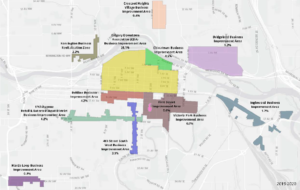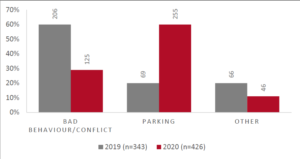


By Nick Barnsdale
Toronto is nearing a decision on legalizing e-scooters, the electric-powered, stand-up scooters that have surged in popularity as a mode of transportation in recent years.
Ontario announced a pilot project at the beginning of 2020 to allow e-scooters in the province, but it’s still up to municipalities to pass by-laws legalizing them. Toronto City Council sent the issue to committee and asked staff for a report on their safety and viability. Staffers are expected to return with findings as early as this month.
“The key appeal and popularity of e-scooters is that they are fun and convenient, particularly to people under the age of 35,” says the city’s report. “They are often used for recreation and touring, but can also be used as a method of commuting or for taking short utilitarian trips. They reduce effort and sweat from exertion compared to human-powered kickscooters and bicycles. They also enable people to go farther distances than on foot.”
E-scooters have become popular in many cities that have legalized them. Calgary approved e-scooter usage in 2018, along with e-bikes, and permitted three companies to rent out scooters and bikes within the city. In the municipality’s initial two-year pilot project period, more than 200,000 unique riders took about 1.9 million trips, according to the city’s 2020 report. Calgary also found that the program had environmental and economic benefits.
“The citizen e-scooter survey results show that a third of e-scooter trips replace a car trip,” the report says. “E-scooters and e-bikes are electrically powered and do not have tail pipe emissions.
“Approximately 55% of shared e-Scooter and e-Bike trips ended in [Business Improvement Area] areas, which feature small local businesses. The shared micromobility companies (the businesses which rented out the scooters) hired 82 full time, 22 part time, and numerous contract staff in Calgary.”

A map of the visits via e-scooter to Business Improvement Areas and Business Revitalization Zones in Calgary. Photo credit: Shared e-Bike and e-Scooter Final Pilot Report
Ottawa, which began a similar program in June 2020, recorded more than 72,720 unique riders and greater than 238,000 rides from Jun. 16, 2020 to Oct. 31, 2020. About 46 per cent of 1,856 respondents to the city’s survey said that they drove less as a result of the availability of e-scooters. Seventy-six per cent of the reasons for a trip included “for fun or leisure,” indicating that citizens enjoy riding e-scooters. Thirty-four per cent said they used the service to travel to and from local businesses, which the city interpreted as a boost to the economy.
“Trip data demonstrated that 48 per cent of e-scooter trips started in a Business Improvement Area (BIA) and 45 per cent ended in a BIA, indicating that e-scooters brought residents to local businesses and supported Ottawa’s economic recovery during the COVID-19 pandemic,” the report says.
While e-scooters have shown economic and environmental benefits for the city and seem to be popular amongst citizens, there are safety concerns — not just for riders — that may deter Toronto from giving them the green light.
Accessibility advocates have campaigned against allowing e-scooters on city streets due to their danger to visually-impaired people. The concern is that the scooters, which are nearly silent, can be impossible to detect for the visually impaired. Furthermore, they can be tripping hazards if improperly parked on a sidewalk.
Greg Thomson, in a press release for the Accessibility for Ontarians with Disabilities Act Alliance wrote that “blind people like myself cannot detect silent e-scooters accelerate at us at over 20 KPH, driven by unlicensed, untrained, uninsured, unhelmeted fun-seeking riders. Left strewn on sidewalks, e-scooters are tripping hazards for people with vision loss and an accessibility nightmare for wheelchair users.”
The Alliance recommended that Toronto not undertake a pilot project to test the viability of e-scooters, saying that “City Council should not conduct and experiment that endangers Torontonians.” The Toronto Accessibility Advisory Committee of City Council announced that it “does not support the use of any electric kick-scooters (e-scooters) including any pilot project in the City of Toronto” in a decision made on Feb. 25, 2021. It also requested a ban on all use of e-scooters in public areas with no exceptions, citing general safety, danger to those with disabilities and the elderly, poorly enforced laws, and more load on already insufficient infrastructure.
Kash Mushtaq, Director of Business Development at Burlington-based e-scooter merchant Smartwheel, suggested different laws when passing pedestrians.
“I think they need to add this rule: if you’re crossing a pedestrian, ring a bell before you approach them, and the cross them at no more than 6 km/h speed,” he said. He suggested that the process should make e-scooters no different from mobility scooters when passing on sidewalks.
Public Health Ontario released a literature review of public studies on the safety and efficacy of e-scooters. Twenty-one reports were considered. In a United States study by the National Electronic Injury Surveillance System (NEISS), there were an estimated 32,400 scooter injuries from 2013-17 — around 2.5 cases per 100,000. The rate did not sufficiently fluctuate over time. Head injuries were the most common injury type at 27.6 per cent of all incidences; fractures and dislocations at 25.9 per cent were diagnosed the most. The study found that there were no deaths.
Another United States study conducted from 2000-2017 showed that there was no evidence of e-scooters colliding with pedestrians more than bicycles. This conflicts with the City of Calgary’s data which suggests that e-scooters could be up to 100 times more likely than a shared bicycle to result in an injury on a per-trip basis. It also found that e-scooter injuries are more likely to be concussions than those resulting from e-bikes. It reported much higher injury rates than the 2013-2017 study, finding that about 53 per 100,000 presentations to the emergency room were e-scooter related. A different study found that over a 10-year period of 2008-2017, the annual number of incidents tripled. Several of them concurred that powered scooters had a higher rate of head injuries than non-powered scooters. Many of the studies agreed that head injuries and fractures are the most common.
In the City of Calgary’s pilot project, there were 75 injuries that required an ambulance. This amounts to a rate of about 4 injuries per 100,000 trips. No fatalities occurred. However, there were around 1,300 results for “e-scooter” in the Alberta Health Services database for emergency room check-ins. The report by the city says that this figure may be inflated due to the search methodology, but if accurate, it would indicate a rate of 68.4 injuries per 100,000 trips. Calgary received 2.6 complaints per day regarding e-scooters, which indicates that concerns over the safety of people with disabilities could be well-founded.

A graph of the reasons for 311 calls relating to e-scooters. Photo credit: Shared e-Bike and e-Scooter Final Pilot Report
Mushtaq said that Toronto should avoid a dockless model, which does not force riders to return rented scooters to specific stations, in order to keep sidewalks clear.
“The dockless idea is terrible because they’ll be leaving them everywhere,” he said. “They become vandalized, that becomes property damages, and that actually looks very bad on the city because they just throw them everywhere – I’ve seen it in China, I’ve seen it in Washington, I’ve seen it everywhere, in California too.
Toronto is set to begin considering information regarding e-scooters in April.
“Last year, Toronto City Council requested that staff address e-scooter issues regarding safety, accessibility and insurance and liability and return to Council with and update,” the City of Toronto said in a statement. “City staff have since consulted with a variety of stakeholders including the Toronto Accessibility Advisory Committee and other accessibility stakeholders to inform this work.
“Staff expect to report back on all of these issues in a report for the Infrastructure and Environment Committee in late April. It’s expected that the full report and findings will be made public at the time of the meeting.”
Mushtaq said that the city should enact mandatory training and licensing or registration to improve safety and traceability.
“There should be [something] just like a driver’s license,” he said. “A general training and passing a test of one page, or two pages, doesn’t hurt. It’s actually good, because maybe that’s how you get the permit [to operate an e-scooter]; maybe that training should be mandatory to get the permit.
“I’m very positive about this, because without it, it won’t be safe — people will abuse, and there will be problems. But we don’t want to make it complicated; the idea is to keep it simple so people are encouraged to use them.”
He also suggested that ownership should be allowed next to rentals or rideshares, as riders are more likely to ride safely and take better care of scooters they own.
It is expected that councilors will make a decision based on information within the April report.






